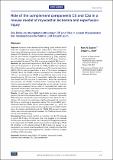| dc.description.abstract | Objective: Ischemic heart disease is the leading cause of death worldwide. The complement system plays a major role in inflammation and tissue injury following myocardial ischemia and reperfusion (MI/R) injury. Systemic C5 inhibition in clinical studies has resulted in mixed results and the role of earlier complement components (e.g., C3a), upstream from C5 cleavage, has not been elucidated for MI/R injury. Therefore, we evaluated the role of C5 or C3a in a mouse model of MI/R injury. Methods: We performed experimental MI/R with 30 min of ischemia and 4 hr of reperfusion in 8–12 wk old C57BL/6 (WT) mice. Systemic C5 or C3a inhibition was performed with an anti-C5 monoclonal antibody (BB5.1) 30 min prior to reperfusion or with a C3a receptor antagonist (C3aRA). Since the C3aRA induces neutropenia that resolves within 120 min, we administered C3aRA at two different time points in two separate groups: 30 min prior to reperfusion within the neutropenic time frame and 120 min prior to reperfusion, when the neutropenia had resolved, but C3aRA remained active. Following MI/R, cardiac function was assessed via echocardiography, serum troponin I concentrations were measured as an index of myocardial cell death and myocardial inflammation was determined via myocardial polymorphonuclear leukocyte (PMN) infiltration. Results: In wild type mice, MI/R significantly decrease myocardial ejection fraction and increased serum troponin I levels and myocardial PMN infiltration compared to sham-operated animals. Systemic C5 inhibition, 30 min prior to reperfusion, significantly protected mice from MI/R injury, confirming an important role for C5 in murine MI/R injury. Treatment with the C3aRA, 30 min prior to reperfusion (i.e., within the neutropenic time frame), protected mice significantly from MI/R related injury. In contrast, administration of the C3aRA 120 min prior to reperfusion, when the neutropenia had resolved, but C3aRA remained active, did not prevent MI/R injury. Conclusions: These results confirm an important role for C5 cleavage in murine MI/R injury. At the same time, they suggest a minimal role for C3a, since neutropenia rather than C3a receptor antagonism appears to be responsible for C3aRA related amelioration in MI/R injury. While C5 inhibition in the clinical setting of MI/R does not appear to be therapeutic, our results raise the possibility that inhibition of either C5a or C5b-9 may be more advantageous than inhibition of C3a or complete inhibition of C5 in humans. | en_US |


